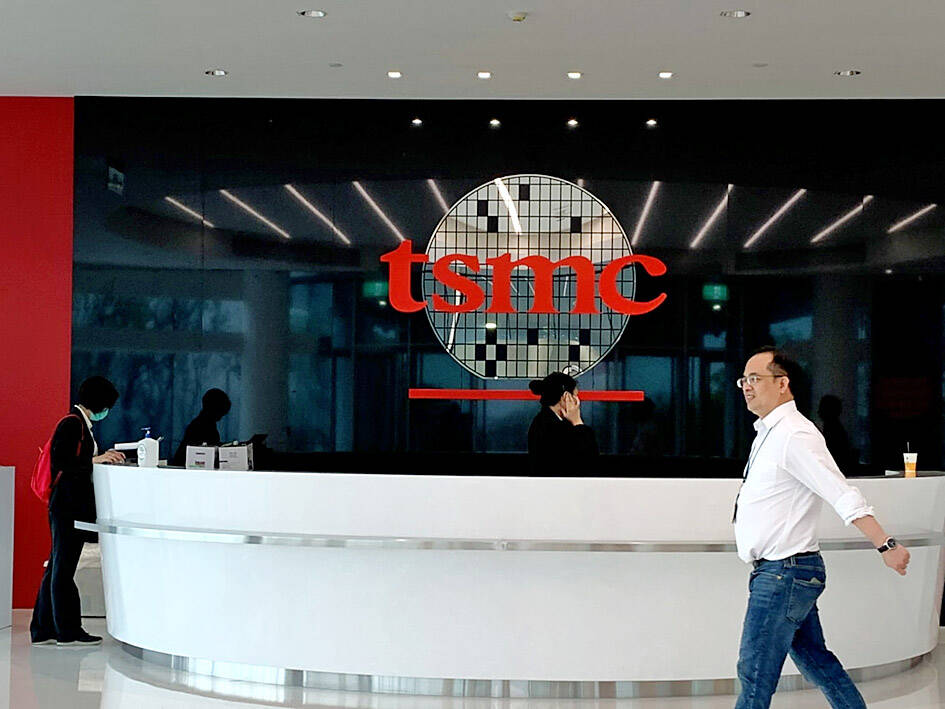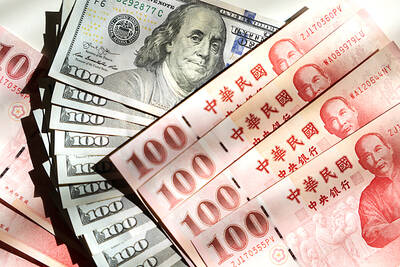The bullish chorus on Taiwan Semiconductor Manufacturing Co (TSMC, 台積電) is growing even louder, as a stock rally puts its market capitalization closer to the US$1 trillion milestone.
A flurry of Wall Street brokerages this week have lifted their price targets for TSMC, citing surging artificial intelligence (AI) related demand and potential price hikes to drive up earnings.
Goldman Sachs Group Inc is the most bullish, increasing its price target by 19 percent to NT$1,160, as it sees 3 and 5-nanometer chip manufacturing prices advancing by a “low single digit percentage.”

Photo: Grace Hung, Taipei Times
JPMorgan Chase & Co said TSMC might “lift its 2024 revenue guidance and potentially move up its capex to the higher end of the guidance range,” and expects AI to contribute 35 percent of total sales by 2028.
Citigroup Inc and Morgan Stanley also raised their price targets on a stronger earnings outlook.
The foundry sector leader has emerged as a major beneficiary of the widening adoption of AI, with its cutting-edge technology and valuation making it a favorite play among global investors. TSMC has also prospered from being the main advanced-chip supplier of Nvidia Corp — recently crowned the world’s most valuable company.
TSMC shares yesterday rose 4.03 percent to close at a new high of NT$981 in Taipei trading, after hitting an intraday high of NT$984, in the wake of a 3.51 percent rise in Nvidia stock on Wall Street overnight.
The Taiwanese chipmaker last week overtook Berkshire Hathaway Inc to become the eighth-largest company globally in terms of market capitalization, based on the firm’s American depositary receipts (ADRs). The ADRs’ 73 percent gain this year has boosted TSMC’s market value to US$932 billion, shy of the US$1 trillion threshold.
“We now see even more attractive risk-reward for TSMC amid the growing, positive sentiment around AI,” Goldman analysts including Bruce Lu (呂昆霖) wrote in a note on Tuesday. “With the ongoing proliferation of AI, we see TSMC among the key beneficiaries.”
Separately, TrendForce Corp (集邦科技) yesterday said that TSMC is considering price hikes for advanced process technology nodes in the second half of this year, in a bid to absorb higher utility and construction costs for its overseas fabs.
TrendForce did not give precise forecast about how much TSMC would increase prices. Speculations have been circulating that the price hikes for 3-nanometer chips could be around 5 percent since early this month.
TSMC chairman C.C. Wei (魏哲家) told reporters on June 4 that there was room for price upticks as the firm offered the most cost-effective chips to customers.
Strong appetite for 3, 4 and 5-nanometer technologies — which are used to produce advanced chips for devices with AI features and to make high-performance computing chips for data centers — gives TSMC leeway to negotiate for better prices, the Taipei-based researcher said in a report.
The chipmaker’s manufacturing equipment to produce 3, 4 and 5-nanometer chips are operating at full capacity and would exceed 100 percent in the third and fourth quarters, TrendForce said.
The order visibility could even go further to next year, it added.
Smaller foundry companies Powerchip Semiconductor Manufacturing Corp (力積電子) and Vanguard International Semiconductor Corp (世界先進) are also expected to see their factory utilization improve to between 70 percent and 80 percent later this year, but they are unlikely to raise prices as demand for mature technology remains muted, TrendForce said.
Additional reporting by Lisa Wang

MARKET LEADERSHIP: Investors are flocking to Nvidia, drawn by the company’s long-term fundamntals, dominant position in the AI sector, and pricing and margin power Two years after Nvidia Corp made history by becoming the first chipmaker to achieve a US$1 trillion market capitalization, an even more remarkable milestone is within its grasp: becoming the first company to reach US$4 trillion. After the emergence of China’s DeepSeek (深度求索) sent the stock plunging earlier this year and stoked concerns that outlays on artificial intelligence (AI) infrastructure were set to slow, Nvidia shares have rallied back to a record. The company’s biggest customers remain full steam ahead on spending, much of which is flowing to its computing systems. Microsoft Corp, Meta Platforms Inc, Amazon.com Inc and Alphabet Inc are

Luxury fashion powerhouse Prada SpA has acknowledged the ancient Indian roots of its new sandal design after the debut of the open-toe footwear sparked a furor among Indian artisans and politicians thousands of miles from the catwalk in Italy. Images from Prada’s fashion show in Milan last weekend showed models wearing leather sandals with a braided design that resembled handmade Kolhapuri slippers with designs dating back to the 12th century. A wave of criticism in the media and from lawmakers followed over the Italian brand’s lack of public acknowledgement of the Indian sandal design, which is named after a city in the

The US overtaking China as Taiwan’s top export destination could boost industrial development and wage growth, given the US is a high-income economy, an economist said yesterday. However, Taiwan still needs to diversify its export markets due to the unpredictability of US President Donald Trump’s administration, said Chiou Jiunn-rong (邱俊榮), an economics professor at National Central University. Taiwan’s exports soared to a record US$51.74 billion last month, driven by strong demand for artificial intelligence (AI) products and continued orders, with information and communication technology (ICT) and audio/video products leading all sectors. The US reclaimed its position as Taiwan’s top export market, accounting for

INVESTOR RESILIENCE? An analyst said that despite near-term pressures, foreign investors tend to view NT dollar strength as a positive signal for valuation multiples Morgan Stanley has flagged a potential 10 percent revenue decline for Taiwan’s tech hardware sector this year, as a sharp appreciation of the New Taiwan dollar begins to dent the earnings power of major exporters. In what appears to be the first such warning from a major foreign brokerage, the US investment bank said the currency’s strength — fueled by foreign capital inflows and expectations of US interest rate cuts — is compressing profit margins for manufacturers with heavy exposure to US dollar-denominated revenues. The local currency has surged about 10 percent against the greenback over the past quarter and yesterday breached